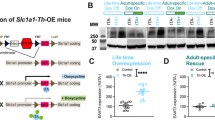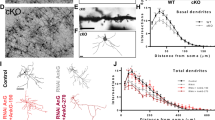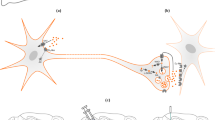Abstract
Lithium has been used extensively for mood stabilization, and it is particularly efficacious in the treatment of bipolar mania. Like other drugs used in the treatment of psychiatric diseases, it has little effect on the mood of healthy individuals. Our previous studies found that mice with a mutation in the Clock gene (ClockΔ19) have a complete behavioral profile that is very similar to human mania, which can be reversed with chronic lithium treatment. However, the cellular and physiological effects that underlie its targeted therapeutic efficacy remain unknown. Here we find that ClockΔ19 mice have an increase in dopaminergic activity in the ventral tegmental area (VTA), and that lithium treatment selectively reduces the firing rate in the mutant mice with no effect on activity in wild-type mice. Furthermore, lithium treatment reduces nucleus accumbens (NAc) dopamine levels selectively in the mutant mice. The increased dopaminergic activity in the Clock mutants is associated with cell volume changes in dopamine neurons, which are also rescued by lithium treatment. To determine the role of dopaminergic activity and morphological changes in dopamine neurons in manic-like behavior, we manipulated the excitability of these neurons by overexpressing an inwardly rectifying potassium channel subunit (Kir2.1) selectively in the VTA of ClockΔ19 mice and wild-type mice using viral-mediated gene transfer. Introduction of this channel mimics the effects of lithium treatment on the firing rate of dopamine neurons in ClockΔ19 mice and leads to a similar change in dopamine cell volume. Furthermore, reduction of dopaminergic firing rates in ClockΔ19 animals results in a normalization of locomotor- and anxiety-related behavior that is very similar to lithium treatment; however, it is not sufficient to reverse depression-related behavior. These results suggest that abnormalities in dopamine cell firing and associated morphology underlie alterations in anxiety-related behavior in bipolar mania, and that the therapeutic effects of lithium come from a reversal of these abnormal phenotypes.
Similar content being viewed by others
Log in or create a free account to read this content
Gain free access to this article, as well as selected content from this journal and more on nature.com
or
References
Barton Jr CD, Dufer D, Monderer R, Cohen MJ, Fuller HJ, Clark MR et al (1993). Mood variability in normal subjects on lithium. Biol Psychiatry 34: 878–884.
Dong Y, Green T, Saal D, Marie H, Neve R, Nestler EJ et al (2006). CREB modulates excitability of nucleus accumbens neurons. Nat Neurosci 9: 475–477.
Dzirasa K, Coque L, Sidor MM, Kumar S, Dancy EA, Takahashi JS et al. (2010). Lithium ameliorates nucleus accumbens phase-signaling dysfunction in a genetic mouse model of mania. J Neurosci 30: 16314–16323.
Easton A, Arbuzova J, Turek FW (2003). The circadian Clock mutation increases exploratory activity and escape-seeking behavior. Genes Brain Behav 2: 11–19.
Franklin K, Paxinos G (1997). The mouse brain in stereotaxic coordinates, Academic Press: San Diego.
Goldberg M, Fleming SM, Palacin JJ, Cepeda C, Hoa LA, Bhatangar A et al (2003). Parkin-deficient mice exhibit nigrostriatal deficits but not loss of dopaminergic neurons. J Biol Chem 278: 43628–43635.
Grace AA, Onn SP (1989). Morphology and electrophysiological properties of immunocytochemically identified rat dopamine neurons recorded in vitro. J Neurosci 9: 3463–3481.
Grandjean EM, Aubry JM (2009). Lithium: updated human knowledge using an evidence-based approach: Part I: clinical efficacy in bipolar disorder. CNS Drugs 23: 225–240.
Hampp G, Ripperger JA, Houben T, Schmutz I, Blex C, Perreau-Lenz S et al. (2008). Regulation of monoamine oxidase A by circadian-clock components implies clock influence on mood. Curr Biol 18: 678–683.
Han MH, Bolanos CA, Green TA, Olson VG, Neve RL, Liu RJ, Aghajanian GK et al (2006). Role of cAMP response element-binding protein in the rat locus ceruleus: regulation of neuronal activity and opiate withdrawal behavior. J Neurosci 26: 4624–4629.
Hood S, Cassidy P, Cossette M-P, Weigl Y, Verwey M, Robinson B et al. (2010). Endogenous dopamine regulates the rhythm of expression of the clock protein Per2 in the rat dorsal striatum via daily activation of D2 dopamine receptors. J Neurosci 30: 14046–14058.
King DP, Zhao Y, Sangoram AM, Wilsbacher LD, Tanaka M, Antoch MP et al (1997). Positional cloning of the mouse circadian clock gene. Cell 89: 641–653.
Ko CH, Takahashi JS (2006). Molecular components of the mammalian circadian clock. Hum Mol Genet 15 (Spec No. 2): R271–R277.
Kripke DF, Nievergelt CM, Joo E, Shekhtman T, Kelsoe JR (2009). Circadian polymorphisms associated with affective disorders. J Circadian Rhythms 7: 2.
Krishnan V, Han MH, Graham DL, Berton O, Renthal W, Russo SJ et al (2007). Molecular adaptations underlying susceptibility and resistance to social defeat in brain reward regions. Cell 131: 391–404.
Krishnan V, Han MH, Mazei-Robison M, Iniguez SD, Ables JL, Vialou V et al (2008a). AKT signaling within the ventral tegmental area regulates cellular and behavioral responses to stressful stimuli. Biol Psychiatry 64: 691–700.
Krishnan V, Nestler EJ (2008b). The molecular neurobiology of depression. Nature 455: 894–902.
Malhi GS, Adams D, Berk M (2009). Is lithium in a class of its own? A brief profile of its clinical use. Aust N Z J Psychiatry 43: 1096–1104.
Mansour HA, Talkowski ME, Wood J, Chowdari KV, McClain L, Prasad K et al (2009). Association study of 21 circadian genes with bipolar I disorder, schizoaffective disorder, and schizophrenia. Bipolar Disord 11: 701–710.
Marinelli M, White FJ (2000). Enhanced vulnerability to cocaine self-administration is associated with elevated impulse activity of midbrain dopamine neurons. J Neurosci 20: 8876–8885.
McClung CA (2007). Circadian genes, rhythms and the biology of mood disorders. Pharmacol Ther 114: 222–232.
McClung CA, Sidiropoulou K, Vitaterna M, Takahashi JS, White FJ, Cooper DC et al (2005). Regulation of dopaminergic transmission and cocaine reward by the Clock gene. Proc Natl Acad Sci USA 102: 9377–9381.
McGrath CL, Glatt SJ, Sklar P, Le-Niculescu H, Kuczenski R, Doyle AE et al (2009). Evidence for genetic association of RORB with bipolar disorder. BMC Psychiatry 9: 70.
Mukherjee S, Coque L, Cao JL, Kumar J, Chakravarty S, Asaithamby A (2006). The mesolimbic dopamine reward circuit in depression. Biol Psychiatry 59: 1151–1159.
Mukherjee S, Coque L, Cao JL, Kumar J, Chakravary S, Asaithamby A et al (2010). Knockdown of Clock in the ventral tegmental area through RNA interference results in a mixed state of mania and depression-like behavior. Biol Psych 68: 503–11.
Nestler EJ, Carlezon WA Jr et al (2006). The mesolimbic dopamine reward circuit in depression. Biol Psych 59: 1151–1159.
Nierenberg AA (2008). Effective agents in treating bipolar depression. J Clin Psychiatry 69: e29.
Nievergelt CM, Kripke DF, Barrett TB, Burg E, Remick RA, Sadovnick AD et al (2006). Suggestive evidence for association of the circadian genes PERIOD3 and ARNTL with bipolar disorder. Am J Med Genet B 141B: 234–241.
O’Donnell KC, Gould TD (2007). The behavioral actions of lithium in rodent models: leads to develop novel therapeutics. Neurosci Biobehav Rev 31: 932–962.
Roybal K, Theobold D, Graham A, DiNieri JA, Russo SJ, Krishnan V et al (2007). Mania-like behavior induced by disruption of CLOCK. Proc Natl Acad Sci USA 104: 6406–6411.
Russo SJ, Bolanos CA, Theobald DE, DeCarolis NA, Renthal W, Kumar A et al (2007). IRS2-Akt pathway in midbrain dopamine neurons regulates behavioral and cellular responses to opiates. Nat Neurosci 10: 93–99.
Soria V, Martinez-Amoros E, Escaramis G, Valero J, Perez-Egea R, Garcia C et al (2010). Differential association of circadian genes with mood disorders: CRY1 and NPAS2 are associated with unipolar major depression and CLOCK and VIP with bipolar disorder. Neuropsychopharmacology 35: 1279–1289.
Ungless MA, Magill PJ, Bolam JP (2004). Uniform inhibition of dopamine neurons in the ventral tegmental area by aversive stimuli. Science 303: 2040–2042.
Viggiano D, Sadile AG (2000). Hypertrophic A10 dopamine neurones in a rat model of attention-deficit hyperactivity disorder (ADHD). Neuroreport 11: 3677–3680.
Vitaterna MH, Ko CH, Chang AM, Buhr ED, Fruechte EM, Schook A et al (2006). The mouse Clock mutation reduces circadian pacemaker amplitude and enhances efficacy of resetting stimuli and phase–response curve amplitude. Proc Natl Acad Sci USA 103: 9327–9332.
Wise RA (1998). Drug-activation of brain reward pathways. Drug Alcohol Depend 51: 13–22.
Young W (2009). Review of lithium effects on brain and blood. Cell Transplant 18: 951–975.
Acknowledgements
We thank Dr Eric Nestler for assistance with the HSV viral vectors. We thank Dr Joe Takahashi for the ClockΔ19 mice. We also thank Kole Roybal, Dr Michelle Mazie-Robinson, Dr Scott Russo, Charles Taylor, Dr Andrea Gillman, and Kristen A Ketcherside for technical help and useful discussions. This study was funded by grants to Dr McClung from the Blue Gator Foundation, NARSAD, the McKnight Foundation, NINDS (R21 NS058339), NIDA (R01DA023988), and NIMH (R01MH082876).
Author information
Authors and Affiliations
Corresponding author
Ethics declarations
Competing interests
Dr McClung has received research funding from GlaxoSmithKline and Pfizer on unrelated project, and honoraria and consulting fees from GlaxoSmithKline, Pfizer, Servier, and Orphagen Pharmaceuticals. All other authors have nothing to disclose.
Rights and permissions
About this article
Cite this article
Coque, L., Mukherjee, S., Cao, JL. et al. Specific Role of VTA Dopamine Neuronal Firing Rates and Morphology in the Reversal of Anxiety-Related, but not Depression-Related Behavior in the ClockΔ19 Mouse Model of Mania. Neuropsychopharmacol 36, 1478–1488 (2011). https://doi.org/10.1038/npp.2011.33
Received:
Accepted:
Published:
Issue date:
DOI: https://doi.org/10.1038/npp.2011.33
Keywords
This article is cited by
-
Mood and behavior regulation: interaction of lithium and dopaminergic system
Naunyn-Schmiedeberg's Archives of Pharmacology (2023)
-
The trilateral interactions between mammalian target of rapamycin (mTOR) signaling, the circadian clock, and psychiatric disorders: an emerging model
Translational Psychiatry (2022)
-
Early Life Social Stress Causes Sex- and Region-Dependent Dopaminergic Changes that Are Prevented by Minocycline
Molecular Neurobiology (2022)
-
Cocaine induces paradigm-specific changes to the transcriptome within the ventral tegmental area
Neuropsychopharmacology (2021)
-
Valproate reverses mania-like behaviors in mice via preferential targeting of HDAC2
Molecular Psychiatry (2021)



